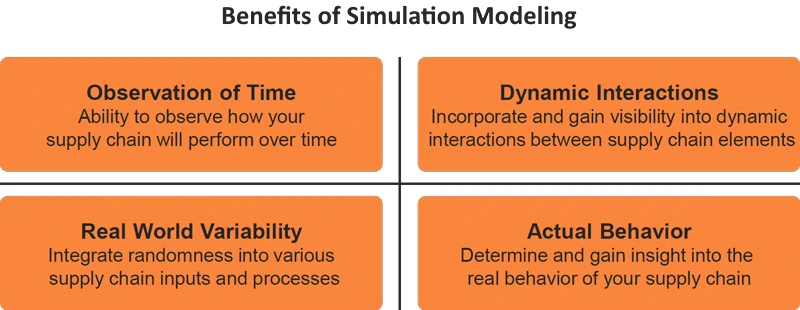Supply chain simulation is different than the analytical methods that have gone before it. It provides dynamic details and opportunities for greater insight by expanding the design, analysis, and optimization toolset for supply chain managers. Furthermore, supply chain simulation is becoming a popular choice as the systems under study become increasingly complex.
To learn more about the technology read the Supply Chain Optimization and Simulation white paper. Or start right away with practice: create a model of your supply chain with anyLogistix simulation software and ensure your supply chain is lean, agile, and robust.
A supply chain simulation shows the behavior of a logistics network over time. The logical rules of a supply chain are represented in a simulation model and then executed over time, making the simulation dynamic. For example, production is started when orders deplete inventory below a threshold. Such rules can be combined, and their relationships investigated as well as tested against disruptive events, like strikes and natural disasters.

Dynamic supply chain simulation models differ from analytical models in several important ways.
An analytical model of a supply chain uses linear equations to describe operations. The benefit of this is that solutions, once found, are optimal. This is also the downside: describing a supply chain in such a way requires simplification and, consequently, the difficulty of modeling increases with complexity. Furthermore, if a solution cannot be found, an analytical model cannot be used. It should also be noted that analytical models deal only with the values they are specified to capture and are of limited use outside their scope.
Dynamic supply chain simulation models capture the rules of operation and enable you to reflect all of the dimensions of your supply chain. The output of a dynamic simulation model shows system behavior over time, and any descriptive statistics of the workings of your supply chain can be collected. Supply chain simulation models cope well with complexity and can consider real-world randomness. If they have a downside, it is that they must be verified to make sure they function as expected.

With the two different approaches, supply chain professionals face a choice.
Modern supply chains generate a lot of data and are subject to a wide variety of risks. Both of these factors increase the complexity of analysis and favor dynamic simulation modeling.
Simulation can be used to:
Simulation is especially useful, when the underlying system is assumed to be too complex to be examined by mathematical-analytical methods. Such complexity arises due to time-dependent, random, and interacting effects within the system.
Together, analytical optimization and dynamic simulation are a powerful combination of methods. They complement each other perfectly when addressing supply chain problems and provide a basis for advanced supply chain development. Using anyLogistix as a supply chain simulator, you can model your supply chain completely and utilize the benefits of both of these methods together.

Read our white paper to find out how the combination of supply chain analytical optimization and dynamic simulation help solve the most complex supply chain problems — Supply Chain Optimization and Simulation: Technology Overview.
try anylogistix